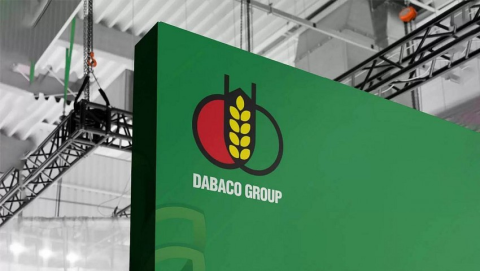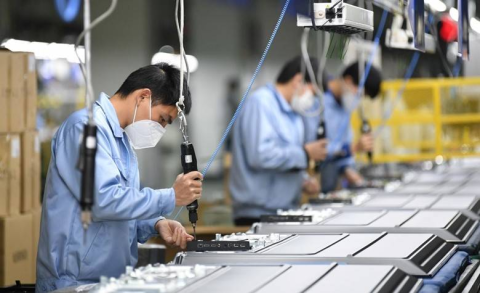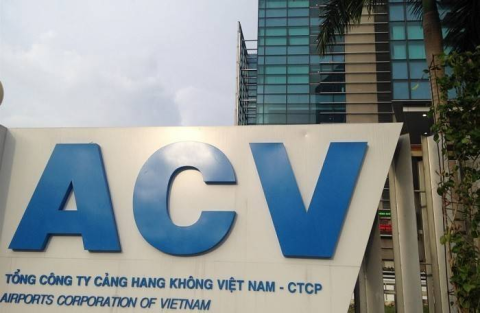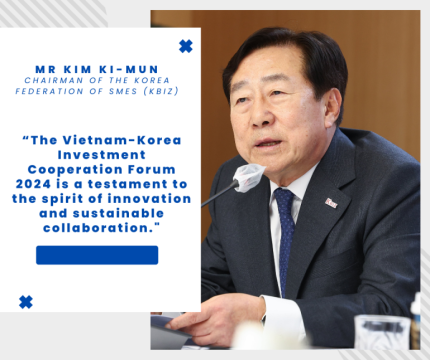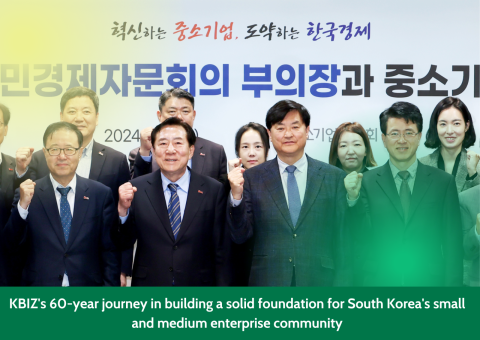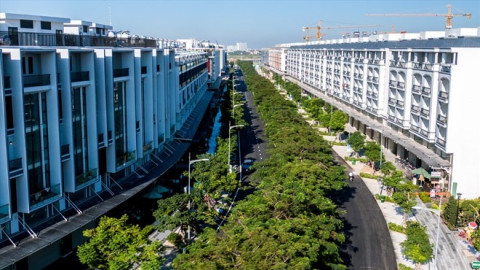What is Starbucks' impression after 10 years of entering the Vietnamese market?
- 905
- Enterprise
- 02:15 20/03/2023
DNHN - While Vietnam is the largest coffee market in Southeast Asia in terms of both value and number of stores, the Starbucks branch rate per million people is a low 0.9%.
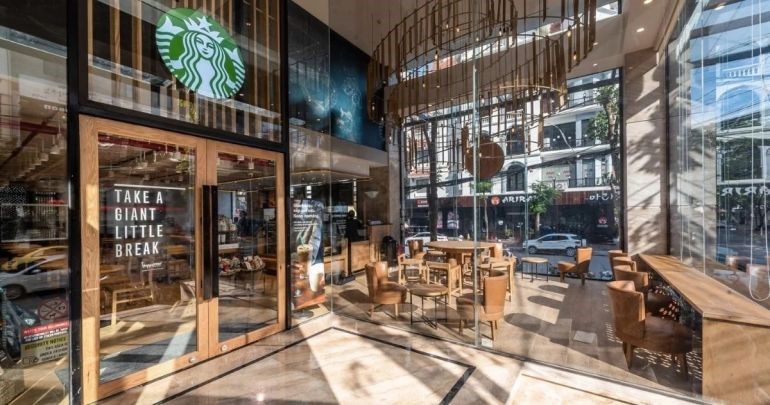
The year 2023 will mark the tenth anniversary of Starbucks' entry into the Vietnamese market. Due to differences in coffee prices, coffee culture, and coffee flavor, however, Starbucks' presence in Vietnam is not particularly significant.
According to Asia Nikkei, coffee has become an integral part of Vietnamese culture, and the country has more coffee shops than almost any other. Therefore, when Starbucks entered the market in 2013, it faced a different set of expectations than other American brands such as McDonald's and Subway. Vietnam before.
A Starbucks representative told Nikkei Asia that the company will celebrate 10 years of operations in Vietnam by opening its 100th location there. However, Starbucks declined to respond to a question regarding the company's profitability in the country.
While Vietnam is the largest coffee market in Southeast Asia in terms of both value and number of stores, the Starbucks branch rate per million people is a low 0.9%. greatest in the region
"Starbucks is not something that can be purchased and consumed every day. Owner of a coffee shop in Ho Chi Minh City, Nguyen Kim Ngan, told Nikkei, "I want to provide people with quality coffee that they can use every day."
Local Vietnamese coffee shops can protect this $1 billion market in part due to their competitive pricing. The unique flavor and coffee-drinking culture are the subsequent reasons why Vietnamese people enjoy drinking Vietnamese coffee.
While Starbucks charges up to $5 for a beverage containing a small amount of Arabica coffee and syrup, competitors sell every possible coffee substitute for as little as $1.
Starbucks's case is ambiguous in the eyes of Enma Bui, a coffee brand representative in Vietnam. On the one hand, she believes that the global giant's presence in Vietnam has increased interest in coffee, while on the other hand, Starbucks' sugary concoction dulls the taste buds.
"One customer approached me and requested a caramel macchiato similar to Starbucks. Enma Bui asked, "How do you persuade someone who is accustomed to such coffee cups to drink black coffee and appreciate its exquisite notes?"
Even while sitting and studying with a Starbucks cup in hand, working at a location of this brand is quite luxurious. However, for a market with a robust coffee culture, this is not something to display or brag about. In this marketplace, sitting and drinking coffee, conversing, working, and studying are our daily activities.
"I believe the population characteristics and coffee-drinking culture in Vietnam explain why world-famous coffee chains are not performing as expected. These brands believe they have performed well in other Asian markets and employ a similar strategy in Vietnam, which is trending towards luxury and high prices, according to Nathaniel Lim of Euromonitor Asia.
Tastes for coffee in Vietnam date back to the nineteenth century. In the 2000s, coffee consumption had become a national habit, dominated by Highlands Coffee and Trung Nguyen. In addition, because the industry has a relatively low barrier to entry, thousands of small coffee shops have emerged. The open economy of Vietnam at the time brought international influences closer to the country.
According to Euromonitor, Vietnam has up to 19,000 coffee shops, just fewer than the United States, China, and South Korea. Despite the size of the Vietnamese market, foreign brands capture a relatively small share.
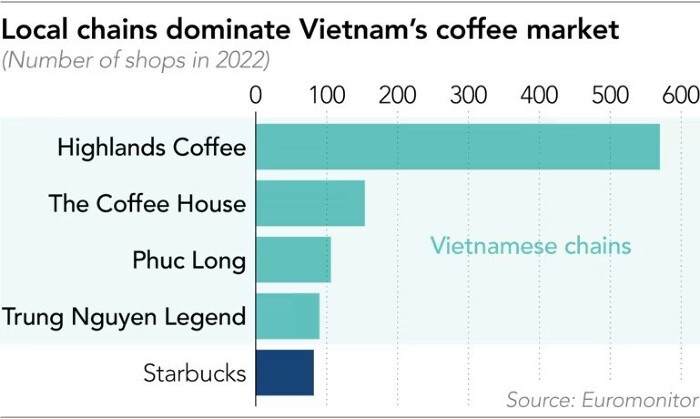
Not many of the first international coffee chain companies to enter Vietnam will survive. After 15 years of expansion, Coffee Bean & Tea Leaf has only 15 locations, while Gloria Jean was forced to leave Vietnam in 2017.
Starbucks Asia Pacific director Emmy Kan told Nikkei, "We will take a cautious, indigenous-cultural approach to sustainable growth," but declined to explain why the company has so few branches in Vietnam.
Vietnam currently has the fewest Starbucks locations in Southeast Asia. Singapore, located directly above, also has 146 stores.
According to a representative of a national coffee brand, coffee in Vietnam is a social activity. People prefer to dine at a restaurant followed by a visit to a coffee shop for a drink, and this behavior eventually becomes a habit. In addition, they prefer a coffee shop that overlooks the street, sometimes located directly on the street or sidewalk, rather than Starbucks.
Two decades ago, Vietnam valued coffee as a profitable export and a daily habit. In recent years, it has taken on the characteristics of a professional craft, with drinkers becoming increasingly aware of the liquid in their glasses and of their participation in a culture.
Exporting coffee remains profitable. According to the US Department of Agriculture, Vietnam exports 25 million bags of nuts annually, second only to Brazil. These 60kg bags primarily contain robusta coffee.
Domestic demand is also extremely robust. According to data from Euromonitor, Vietnam's coffee market expanded by 13% between 2021 and 2022.
How long will it take Starbucks Vietnam or any other international chain to reach this level of expansion? Whether or not they can capitalize on this opportunity is uncertain.
Emmy Kan, president of Starbucks for Asia-Pacific, stated, "We will take a cautious, locally-relevant approach to achieve sustainable growth."
Mai Hoa (t/h)
Related news
- From New Year messages of World Leaders to the “new rules” of the Global economy in 2026
- Connecting Leaders, Shaping the Future: Strategic Leadership Planning Meeting – CorporateConnections Hanoi A
- Sunlight - Unilever Vietnam Recognized for Outstanding Contributions to the National Initiative Supporting Women Entrepreneurs
- Deputy Prime Minister Nguyễn Chí Dũng: “The country’s major challenges weigh heavily on my mind — and we must resolve them together.
- Unitsky String Technologies signs cooperation agreements with three Vietnamese partners, opening a new direction for smart mobility and sustainable development
- When artists do business – livelihood is no poetry!
- Before the D‑day to abolish flat‑rate tax: Fear of technology and costs leave small traders struggling to adapt
- Vietnamese enterprises at a crossroads: the impact of a potential US–China deal
- "Digital technicians" must not be forgotten if Vietnam aims to meet its strategic goals
- HDBank: Impressive profit growth, leading in profitability and advancing international integration
- TNI King Coffee sued for over VND 5 Billion in unpaid debts
- VINASME and Jeonnam Technopark Sign MOU on technology cooperation, human resource training, and trade promotion
- Vietnamese entrepreneurs strengthen ASEAN connectivity in the digital iIntegration era
- Prime Minister: Vietnam aims to become a regional logistics hub
- Vietnam upgraded to Secondary Emerging Market by FTSE Russell
- Hanoi’s economy grows 7.92% in first nine months of 2025, FDI surges nearly threefold
- Vietnam’s strong gdp growth fails to ease labor market distress
- US tariffs on Brazil propel Vietnam’s pangasius into global spotlight
- VietLeap AI Accelerator launches: A strategic springboard for Vietnam’s AI startups
- CICON expands strategic alliances: A new step forward in Vietnam–Korea business connectivity
Đọc thêm Enterprise
List of Vietnam’s 25 Best Workplaces 2025
Great Place To Work® has officially announced the 25 companies featured in the Best Workplaces in Vietnam™ 2025 ranking.
The ambitions of major enterprises in 2025
Major enterprises such as Dabaco, FPT, and KBC have set ambitious plans for 2025, demonstrating flexibility and sharpness in their business strategies.
What do domestic businesses need to overcome difficulties?
Strong and synchronized government support policies are crucial in helping Vietnamese enterprises navigate the current challenging period.
ACV achieved net profit surpassing VND 11,560 billion in 2024
Vietnam Airports Corporation (ACV) has recently announced its 2024 business results, reporting a net profit exceeding VND 11,560 billion, marking a 37% growth compared to the previous year.
Increasing taxes on pick-up trucks: The need to hear public opinion
The proposed tax increase on pick-up trucks is sparking debate. Many representatives argue that this decision could impact workers, businesses, and the domestic automotive market.
"The Vietnam-Korea Investment Cooperation Forum 2024 is a testament to the spirit of innovation and sustainable collaboration."
For Mr. Kim Ki-mun, Chairman of KBIZ, the Vietnam-Korea Investment Cooperation Forum 2024, scheduled for November 21, is not merely an event but also a testament to the spirit of innovation and sustainable collaboration between nations.
KBIZ's 60-year journey in building a solid foundation for South Korea's small and medium enterprise community
With over 60 years of establishment and development, the Korea Federation of SMEs (KBIZ) has emerged as a pioneering force in supporting the small and medium-sized enterprise (SME) community in South Korea.
What categories are included in the additional audit subjects?
On the morning of November 7, the National Assembly discussed the draft amendment of several articles across seven laws, with a particular focus on adding new audit subjects.
Institutional obstacles "tie up" enterprises and challenge economic growth
During a session discussing the 2024 socio-economic development plan, National Assembly deputies emphasized that institutional barriers remain a significant "obstacle" for businesses.
More than 1,000 new real estate businesses established in Ho Chi Minh City, transactions grow
In the first nine months of 2024, Ho Chi Minh City's real estate market witnessed the establishment of over 1,000 new businesses and recorded 1,600 property transactions, signaling a positive recovery trend.



